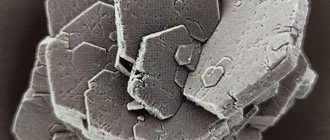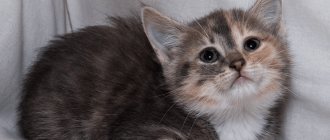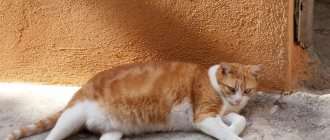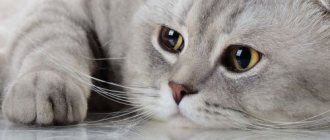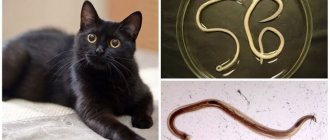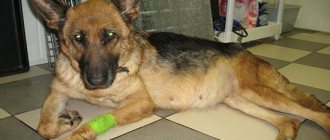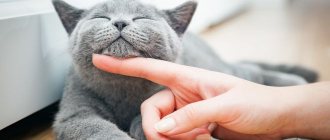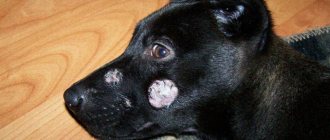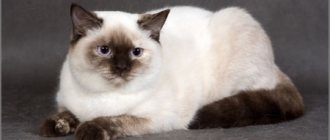Save article:
Urolithiasis (UKD) or urolithiasis is a serious disease of the excretory system in which sand and urinary stones accumulate in the cat's bladder, kidneys or ureters. The disease not only worsens the well-being of animals, causing them to suffer, but also directly threatens life. ICD has a certain set of symptoms that can be used to suggest the development of pathology. In case of a confirmed diagnosis, veterinarians use complex therapy and recommend effective measures to prevent urolithiasis.
Features of the disease
KSD is a chronic pathology: the animal develops salt deposits in the form of stones or sand in the kidneys, urinary ducts, and bladder. Every fourth individual is at risk of experiencing these symptoms. Animals from two to six years old, cats with impressive weight, breeds with long hair, castrated males and unsterilized females are susceptible to the disease.
Manifestations
Males experience the pain of passing stones or sand more often, since their urethra is much narrower than that of females. Periods of exacerbation include the beginning of autumn, as well as the time from January to April.
At first, the disease is not noticed because it does not manifest itself. However, further formations will only increase in size, and one day a moment will come when the formation will move away from the wall of the bladder or kidney and begin to move with the flow of secretions.
Even the smallest formation causes extreme pain to the cat, causing mechanical damage to the delicate surface of the urethra. Impressive-sized salt formations can clog the urinary duct - this is called obstruction. The fluid stagnates, burning pain and intoxication appear. In this case, prompt emergency assistance must be provided, otherwise the animal will simply die.
Types of formations
ICD manifests itself in two types of formations: struvite and oxalate. For the first, an alkaline environment is needed - if there is an excess of phosphorus and magnesium in the body, then the urine becomes alkaline. Struvite has a harder structure.
Oxalates are formed if the urine pH is very acidic. It is caused by high amounts of calcium. Oxalates are special in that they have sharp edges and a loose structure.
Exacerbation of chronic pancreatitis
Chronic pancreatitis may hardly manifest itself until the period of exacerbation. Relapse of the disease is usually associated with two main reasons3:
- alcohol consumption. Even a small amount of alcohol consumed can provoke the transition of the disease into the acute phase;
- violation of the diet, overeating, a large number of fatty, fried, spicy dishes on the menu.
Other factors can also provoke exacerbation of chronic pancreatitis in adults, for example, chronic stress, physical fatigue, poisoning or the toxic effects of certain medications3.
Exacerbation of the disease is manifested by the following symptoms3:
- attack of acute or dull pain in the hypochondrium. Painful sensations spread to the subscapular region or the entire back;
- progressive diarrhea. In this case, the feces have a characteristic greasy shine. Undigested food remains are often observed in the stool;
- the occurrence of specific bitterness in the oral cavity, nausea and loss of appetite;
- whitish coating on the surface of the tongue;
- weight loss.
Exacerbation of chronic pancreatitis in adults can last for one to two weeks. You cannot fight the disease on your own during this period: the best solution is hospitalization and constant monitoring by specialists.
Causes of ICD
It is difficult to identify the main and only source: usually veterinarians determine a combination of factors contributing to the onset of the disease. Exogenous (caused from outside) causes include:
- Poor nutrition
. There are various options here: poor or cheap food, low fluid intake, poor drinking water, excessive consumption of minerals, fish and fatty foods, overfeeding the animal. All this disrupts metabolism and changes the pH of urine. A favorable environment is created for the formation of sand and rocky formations.
- Climatic features
. If the air temperature is high, the discharge becomes much more concentrated than under normal conditions. Water with a lot of salts in this case becomes a secondary cause of this condition.
- Vitamin A deficiency
. This element has a beneficial effect on the cells of the mucous membrane of the genitourinary system, and its absence significantly weakens the resistance and regeneration of organs.
But even a well-groomed cat with a balanced diet and favorable living conditions can develop urolithiasis. It is often caused by endogenous (internal) factors, which include:
- Hormonal disorders.
- The presence of chronic diseases, foci of inflammation, congenital pathologies in the development of the genitourinary system.
- Individual anatomy of the animal: for example, a very thin, long or curved urethra.
- Interruptions in the gastrointestinal tract. The acid-base balance will be disturbed, resulting in illness.
- Various infections and complications after them.
- Genetic predisposition: ICD can be passed on from generation to generation. Any unfavorable conditions will promptly start the process.
- A sedentary lifestyle that causes obesity.
Problems with kidney and urinary stones are quite common, and it is impossible to completely protect against them. But if you carefully care for your cat and feed it properly, the risk of disease is significantly reduced.
Factors influencing the development of the disease
photo from the site: www.zoogruming.ru
Some people think that urolithiasis occurs only in neutered cats. But an operation to remove the testes can cause the appearance of urolithiasis only if it was performed too early and the organs of the excretory system remained underdeveloped.
Next, we will look at the main phenomena that contribute to the development of the disease.
- Climatic and geochemical features - it turns out that high air temperature can also affect the frequency of urges. With an increased rate, primary urine is formed extremely rarely. Because of this, it is excreted in concentrated form. The composition of the water that the animal drinks every day and the soil also affects the pet’s body. Thus, exceeding the permissible level of lime salts leads to a decrease in the acidity of urine - stones are formed from accumulated crystals.
- Features of the diet - the concentration of carbamide depends on how much protein your cat consumes. Excessive protein content in the diet when purine metabolism is disrupted leads to the occurrence of urolithiasis. In this case, it is necessary to reduce the protein content in the menu. The result of such a reasonable limitation will be a reduction in the amount of substrate that provokes the growth of pathogenic bacteria. At the same time, excesses can only aggravate the situation: a vegan diet for your cat or an abundance of dairy products is a direct path to alkaline urolithiasis.
- A-vitaminosis - a lack of retinol provokes the development of urolithiasis. Make sure that your cat's diet contains special supplements or necessary plant products (butter, boiled or raw carrots). Often, A-vitaminosis can also occur in a cat that regularly replenishes retinol reserves. Poor functioning of the gastrointestinal tract is to blame - malabsorption and the inability of the liver to convert beta-carotene into retinol.
The following external factors can also lead to urolithiasis:
- Hormonal imbalance - for example, excess parathyroid hormone can lead to increased calcium levels - not only in the blood, but also in the urine. And crystals of salts released from the bone tissue of the body are the building material for stones.
- Features of anatomy - the urethral canal in cats is a curved tube that changes its position in front of the penis bone. It is at the point of the bend that the urine stops and is inhibited. When a pet is castrated early, the canal remains undeveloped, with a small diameter of the tube - and this is another reason for the formation of stones.
- Pathologies of the digestive system - gastritis, colitis and other gastrointestinal diseases, which occur not only in bipeds, but also in their smaller brothers, lead to a violation of the ratio of acid and alkali in the animal's body. As a result, there is a decrease in calcium excretion in the urine.
- Infectious diseases - infectious agents enter the urinary system in three ways: from the intestines and genitals, from the urethra or from distant sources.
In the latter case, stones and microorganisms are interconnected. Stones make it difficult to pass urine, creating a favorable environment for the development of microbes that provoke a new round of infection. And the latter, which has become chronic, promotes the accumulation of salt crystals and their binding into minerals of different shapes, sizes and consistencies.
Symptoms of the disease by stages
When the disease just begins to develop, it is very difficult to notice. Symptoms at the primary stage are not clearly expressed, so the owner does not pay attention to minor changes in the cat’s behavior. The furry friend becomes apathetic, does not want to be active, eats poorly, and experiences discomfort when going to the toilet.
Sometimes owners learn about a dangerous pathology when drastic measures are required. When solid formations form, the main symptoms can already be clearly seen. Their intensity is divided into three degrees:
1. Initial stage.
The cat takes a long time to go to the toilet, and it will relieve itself in a variety of places - psychologically, the litter box begins to symbolize pain and discomfort. The posture when urinating becomes unusual, the animal becomes very tense. After visiting the tray, your furry friend will lick under the tail for a long time and thoroughly. Little urine is produced and may have a pinkish tint. Sometimes grains of sand are visible in it. The urge to go to the toilet becomes frequent. A cat on a tray often meows due to pain.
2. Acute stage.
The urge to go to the toilet becomes frequent. It happens that the animal experiences incontinence: the four-legged friend will leave wet spots in the resting place, and the owners also notice droplets in his crotch. The stomach becomes denser. Blood is already clearly visible in the discharge. Urine is released drop by drop and has a dark color with a concentrated odor. The pet's condition will be very depressed and lethargic. He usually loses a lot of weight, loses his appetite, and does not play with his favorite toys. Body temperature in some cases rises to 40 ˚С. As the stones move through the urinary canal, the cat will meow restlessly and take a characteristic position to relieve the pain.
3. Critical stage.
Your pet may completely stop going to the litter box. At the same time, painful urges will persist. The discharge will stagnate, causing intoxication of the body - often causing vomiting. Your furry friend will be constantly shaking. In the corners of the mouth you can notice accumulated saliva, viscous and foamy. The stomach will become painful and the cat will almost stop moving. If there is no urination, then after 24-36 hours the reabsorption of waste products begins. Body temperature drops slightly. There are convulsions and loss of consciousness.
It is especially important to see a doctor in the last stage. This condition is considered critical and dangerous for the animal. At this time, minutes count – you can save your pet’s life only by quickly delivering him to a veterinary clinic.
Diagnostics: how to identify pathology
It is important to quickly identify the problem so that you can deal with it and save the life and health of your four-legged friend. To do this, at the slightest suspicion of genitourinary problems, you need to take your pet to a veterinary clinic. The specialist will ask you to describe the cat’s behavior in detail, and then prescribe the necessary studies.
Unfavorable changes can be identified using x-rays, ultrasound, and also by studying the sediment of the discharge in the laboratory and determining the type of salt formation. The composition of the crystal will allow you to understand what kind of prevention and therapy needs to be carried out. The clear presence of salts is determined by qualitative analysis methods: light microscopy, Xray diffraction, etc. The specialist will also prescribe a blood test.
At the appointment, you need to accurately and in detail tell about all the details of keeping the pet, its physical condition, diseases, when the first signs of deviations began to be observed, etc.
Symptoms of chronic pancreatitis
Symptoms of chronic pancreatitis may vary depending on the stage (remission or exacerbation), course and physical condition of the patient. The main signs of the disease are as follows:
- acute pain without clear localization. Pain can be felt in the right hypochondrium, upper or middle abdomen and spread to the back. In many patients, pain occurs immediately after eating, especially if the diet contained fatty, smoked or spicy foods;
- frequent loose stools are one of the main signs of indigestion. Digestive problems in chronic pancreatitis are caused by a lack of enzymes;
- heaviness in the abdomen, nausea, which also indicate a lack of digestive enzymes;
- increasing feeling of hunger, muscle tremors, weakness, cold sweat;
- intoxication, manifested in fever, chronic fatigue, and a feeling of general malaise.
Treatment of urolithiasis
In a veterinary hospital, the elimination of urolithiasis will begin with ensuring patency of the urinary tract. All interventions are carried out under the influence of painkillers or anesthetics. A catheter is used to clean out sand and remove hard structures. After the procedure, the lumen of the urethra is thoroughly washed with a special antiseptic solution.
Treatment is selected individually, based on the degree of neglect of the disease, age, gender, and well-being of the pet. Conservative methods include dissolving stones and eliminating sand with the help of proper nutrition and special diets that increase diuresis. Along with this, antispasmodics and painkillers are used. There is a laser option for intervention. In this case, stones are crushed using a laser and then removed naturally. When the formation cannot be removed, surgery for urolithiasis is indicated for the cat.
Drug therapy
Treatment with tablets and injections is possible if the disease is in its early stages and has no complications. Doctors prescribe a set of medications:
- diuretics;
- anti-inflammatory;
- rehydrants (to restore water-salt balance);
- antibiotics;
- painkillers.
Sometimes homeopathic remedies are added to the list to stimulate the body’s self-recovery.
Catheter placement
If the cat is unable to urinate on his own, a catheter is inserted into his urethra. Sometimes a few hours are enough, and in difficult cases the catheter is left in place for two to three days.
After all formations have come out through the catheter, drug therapy is carried out.
Surgical intervention
If there are significant deposits that exceed the diameter of the urethra, then it is advisable to operate on the cat to remove the stones. Typically, the clinic performs urethrostomy - the creation of an artificial opening in the urethra of a larger diameter. The stones will come out through it.
There is also a more complex operation on the cat’s bladder, called cystotomy - during which stones are removed directly from the opened bladder. This method is used only in extreme cases.
When the intervention has been carried out, the body’s functioning is restored, but an antibacterial and anti-inflammatory course of medications is required.
Is it possible to use folk remedies?
Folk remedies, along with medications, are prescribed by a veterinarian; independent prescription is excluded. Infusions and decoctions of herbs can replace some pharmaceutical drugs - for example, diuretics or immunostimulants.
The dosage and duration of the course of treatment will be calculated by the veterinarian. In some cases, folk remedies may be completely ineffective - they will only delay treatment.
Struvite, risk factors, treatment
Struvite uroliths form when urine becomes oversaturated with magnesium, ammonia and phosphate, and its pH rises to more than 6.5. The solubility of struvite crystals increases at urine pH below 6.5, and at a level of 6.3 struvite stops crystallizing altogether. However, the pH value of urine decreases if animals are fed a diet that promotes increased diuresis and decreased urine concentration (wet food).
Magnesium. Diets containing 0.15-1.0% magnesium (dry matter basis) were associated with the formation of struvite urinary stones in cats. However, the degree of influence of magnesium depended on the form of its compounds and on the pH of the urine.
Phosphorus. With a diet high in phosphorus (3.17-4.70 g/1000 kcal), the incidence of struvite urolithiasis in cats was almost four times higher than in animals fed a diet with a phosphorus concentration of 0.85-1 .76 g/1000 kcal. A high level of phosphorus consumption is accompanied by a more intense excretion in the urine and, as a result, induces its oversaturation with magnesium, ammonia and phosphates.
Treatment
Relief of urinary tract infections. To treat cats, it is necessary to combine dietary therapy with the use of antimicrobial drugs.
It is possible to achieve the dissolution of urinary stones formed by struvite using diet therapy. For this purpose, a diet is used that provides an increase in the volume of urine excreted and a decrease in its pH to a level of 6.3 or less. Such a diet allows you to control the animal's magnesium intake and ensures that the RSS of urine is maintained below unity (the unsaturation zone). It must contain sodium in such an amount that the animals consume more water and produce unconcentrated urine. Sterile struvite uroliths do not require additional antimicrobial therapy.
Prevention of recurrence of urolithiasis. The recurrence rate of struvite urolithiasis in cats is 2.7% with an average duration of remission of 20 months. Therefore, after dissolution or mechanical removal of uroliths, special diets are recommended for cats. This type of preventive diet should maintain urine RSS in areas of unsaturation or metastable saturation, lower urine pH to 6.5 or less, contain plenty of moisture (canned food or other wet foods), and promote increased diuresis (due to increased sodium chloride).
X-ray of the abdominal cavity, the arrow shows a large single urolith
Struvite uroliths from the bladder
Struvite uroliths of various types
Preventative measures after treatment
After the necessary procedures have been completed, care should be taken to maintain the pet’s stable condition. Now he needs preventive measures for life, since the pathology cannot be completely cured - there will always be a risk of exacerbation.
Be sure to visit a veterinary clinic: get tested, do ultrasound examinations. The main preventive measures include:
- True nutrition. It is the appropriate food that will help the animal avoid relapses. Together with a qualified veterinarian, medicinal foods are selected that are specially designed for pets at risk of ICD, or a natural diet is discussed. Everything will depend on the individual characteristics of the furry patient.
- Be sure to monitor your pet's weight. Body weight should not exceed standard values (they are different for each breed). This should be done by limiting the amount of food and adequate physical activity.
- Use herbal medicine and diuretics if this type of therapy is supported by a veterinarian. Herbs will help speed up the healing process.
- To prevent your pet from feeling thirsty, you should use fresh filtered or bottled water. Boiled water, let alone tap water, will not work.
- Observe how often your animal goes to the toilet. Normally, this should happen twice a day.
- The best preventative measure is to keep your pet active. Try to play with your cat more often, giving her the necessary physical activity. Metabolism will become accelerated, and the risk of many diseases will sharply decrease.
- The air in the room should be comfortable. Make sure there are no drafts or hypothermia. Overheating will also be dangerous.
- Every six months it is worth conducting a control ultrasound of the bladder and kidneys. Once every four months - urine and blood tests.
If you adhere to all the basic rules, your family friend will be able to live for a long time without exacerbations and unnecessary suffering. The prognosis for ICD can be favorable - everything depends, first of all, on the care of the owner.
Causes of chronic pancreatitis
One of the most common causes of chronic pancreatitis is poor diet and unhealthy lifestyle. Constant overeating, abuse of fatty foods and alcohol cause blockage of the excretory ducts of the pancreas.
Narrowed excretory ducts provoke the accumulation and premature activation of digestive enzymes. As a result, the pancreas actually begins to digest itself, and inflammation forms1.
In addition, the following factors can lead to chronic pancreatitis3:
- ulcer of the duodenum, stomach and enteritis. Chronic inflammation of the mucous membrane of the gastrointestinal tract makes it difficult to secrete pancreatic juice, which often causes chronic pancreatitis;
- cholelithiasis. After leaving the gallbladder, the stone causes blockage of the common duct and inflammation of the pancreas develops;
- genetic predisposition;
- toxic effects of drugs.
What to feed after treatment for urolithiasis
The main factor in a cat’s longevity will be special nutrition. Some cats eat dry food, while others eat homemade food, so the diet will be different for everyone, although with the same principles. The diet also depends on the type of disorder in salt metabolism.
The oxalate version maintains an effective urine pH of 6.8 to 7.2 and dissolves uroliths. The struvite option aims to restore the density, volume and pH of urine by reducing the consumption of minerals, including magnesium. If you feed your cat natural food, it will take time to create a balanced menu for him.
As for dry food, most of it is not suitable for nutrition, as it contains a lot of mineral salts. For cats with urolithiasis, special ready-made products are suitable, selected by the doctor according to the type of urinary stones:
- oxalates – Royal Cannin Urinary S/O LP34, Hill's PD Feline K/D, etc.;
- struvite – Purina Pro Plan Veterinary Diets UR, Hill's Prescription Diet C/D.
Buy premium and super-premium options. If your furry friend prefers natural food, then you should carefully consider the diet. Veterinarians usually recommend taking vitamins A and B.
With the oxalate option, do not neglect carrots, boiled eggs, and white beets. For struvite – cheese, cottage cheese, boiled meat, rice. An important point is that the food must be fresh. Exclude pork, chicken, fish, sausage, canned food, caviar, do not feed sour, fatty, spicy foods. Also limit your furry friend's protein intake and do not feed him offal - they contain a high content of oxalic acid, which disrupts the pH.
Provide your cat with unhindered access to water. Remember that felines drink little. Therefore, it is necessary to instill in the animal the habit of visiting a “watering hole.” It is better not to keep a bowl of water in the same place as the food bowl, as the animal will switch to food.
Do not change the feeding location as this may cause stress to the animal, especially if it has undergone surgery. Keep food and water fresh.
Remember that the diet must be fully agreed with your doctor. It is a specialist who can give the right recommendations, but independent decisions can lead to dire consequences.
Treatment of chronic pancreatitis
The answer to the question “how to cure chronic pancreatitis” remains open even for modern doctors. The treatment regimen is determined by the doctor for each individual case. The main thing is that therapy should be comprehensive, affecting the main cause of the disease.
Treatment of chronic pancreatitis includes2,3,4:
- immediate cessation of bad habits. Smoking and abuse of strong alcoholic beverages aggravate the inflammatory process and contribute to the subsequent development of the disease;
- strict adherence to the diet. The daily diet should contain high-calorie foods, without spicy foods, salt and pure sugar. You should eat food often, in small portions. In case of exacerbation of chronic pancreatitis, therapeutic fasting is prescribed, which will help stop pancreatic secretion and relieve pain. After 1-3 “hungry” days, the patient is transferred to a special diet;
- basic therapy. In this case, we are talking about taking the following type of drugs: antispasmodics and analgesics, antisecretory and detoxification drugs. Treatment is carried out under the supervision of a doctor with strict adherence to the instructions;
- taking enzyme preparations, the task of which is to compensate for the impaired functioning of the pancreas. The fact is that the pancreas does not recover (it is not the liver), and therefore will no longer be able to work at full capacity during chronic pancreatitis. That is why the first line of therapy is enzyme preparations, which should be taken for life. An example of an enzyme drug prescribed for chronic pancreatitis is Creon®;
- complex therapy. May include taking antispasmodics or analgesics, antisecretory and detoxification medications. Therapy is carried out under the supervision of a physician with strict adherence to the instructions;
- taking anti-inflammatory and painkillers that improve the patient’s well-being;
- herbal medicine, which can be prescribed during remission only as prescribed by a doctor.
What to do if an exacerbation of pancreatitis occurs suddenly, and the ambulance has not yet arrived? Before the doctors arrive, you need to lie down, try to relax your abdominal muscles as much as possible and apply a heating pad with cold water to the sore spot. You should not take painkillers or any other medications - this will interfere with correct diagnosis. And, of course, any food and drinks, even plain water, are strictly prohibited, because any food or liquid can cause increased pain3.
ICD in neutered cats
There is an opinion that castrated cats are most susceptible to this disease, although there is no direct scientific confirmation of this. The only logical chain is this: a castrated male experiences a hormonal imbalance and the activity of the endocrine system changes. This leads to slowness, calmness and leisurely behavior. As a cat gets older, it moves more slowly, reacts less to stimuli and eats more. This can contribute to excess weight gain, which becomes a direct threat to the development of urolithiasis.
Also, older castrates have a slower metabolism. This leads to rare emptying of the bladder and congestion in the genitourinary system and kidneys.
However, it cannot be said that an uncastrated cat is protected from the disease - if he is inactive and overweight, he has every chance of getting sick. Cats suffer from urolithiasis much less frequently, but this does not mean that your girl is not at risk.
Idiopathic | feline interstitial cystitis
An inflammatory non-infectious psychoendocrine disorder, the pathogenesis of which involves the hypothalamic-pituitary-adrenal part of the endocrine system and the central nervous system.
Cats can be born with this predisposition and under certain stressful conditions this disease manifests itself. FIC is a chronic disease that is mild and resolves spontaneously. Relapses are common due to stressful situations. In sick cats, there is a decrease in the size of the adrenal glands.
Cats with idiopathic cystitis are often aggressive, nervous, and fearful.
FIC affects cats under the age of 10 years, without health problems; more often the animals eat only dry food. The relative density of urine is significantly increased in a large number of animals.
Hemorrhagic cystitis - drops of blood are present in the urine.
Calculous cystitis – sand, stones are deposited in the bladder.
Bacterial cystitis is characterized by the presence of bacteria in the urine; normally, urine is bacteria-free and sterile.
Scheme reflecting the proposed pathophysical changes in cats with idiopathic cystitis
How to treat idiopathic cystitis
The main thing is to eliminate stress factors affecting the sick animal.
Irritants:
- Inconvenient location of the toilet;
- Owner's daily routine;
- Change of weather;
- Low mobility of the cat;
- Food;
- Type of filler;
- Strangers and animals in the house.
How to mitigate the effects of stress:
- High complexes for cats;
- Toys that can be chased;
- Various devices for the manifestation of instincts.
Nutrition plays an important role in the pathophysiology and treatment of interstitial cystitis. Sudden and frequent changes often lead to relapses of the disease. The clinical condition of cats improves wet food, reduces the relative density of urine.
A diet with a very low pH is not recommended for cats suffering from FIC, because a decrease in urine pH leads to an increase in the level of irritation of nerve receptors located in the bladder, which creates a feeling of pain in the cat.
